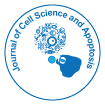Our Group organises 3000+ Global Conferenceseries Events every year across USA, Europe & Asia with support from 1000 more scientific Societies and Publishes 700+ Open Access Journals which contains over 50000 eminent personalities, reputed scientists as editorial board members.
Open Access Journals gaining more Readers and Citations
700 Journals and 15,000,000 Readers Each Journal is getting 25,000+ Readers
Useful Links
Share This Page
Editorial Board
Submit Manuscript
Submit manuscript at https://www.scholarscentral.org/submission/cell-science-apoptosis.html or send as an e-mail attachment to the Editorial Office at cellscience@esciencejournals.com
If you are interested in publishing with us or have any questions, please feel free to contact us directly on WhatsApp .
Table of Contents
About the Journal
Journal of Cell Science and Apoptosis is a peer reviewed journal that focuses on the advancements related to Cell Science by including Cell Therapy, Gene Therapy, Stem cell Science, Cell Signaling, Cell Aging, Cell Mediated Immunity, Autophagy, Cell Culture, Intra Cellular trafficking, Cell Systems, Cell transplantation, Cell metabolism, etc. Topics related to Cell Anatomy, Cell Physiology, Cell Structure, Cell Movement, Cell Signaling, Signal Transduction, Cell Differentiation, Cell Genetics, Stem Cell Biology, RNA Biology, Neurocellular Biology, Cell Cancer Autophagy, Cell Transplantation, and Cell Therapy are form part of this journal.
The Journal also includes research topics that involve Basic and clinically-oriented investigations for programmed cell death. It aims to stimulate research on the basis of mechanisms of apoptosis and its role in affecting public health through cancer, autoimmune disease, viral infection, AIDS, cardiovascular disease, neurodegenerative disorders, osteoporosis and ageing. The editors intend to encourage the development of clinical therapies against apoptosis-related diseases.
The Journal accepts original manuscripts in the form of research article, review article, short communication, case report, letter-to-the-Editor and Editorials for publication. All the published articles are open access and can be accessed online without any subscription charges. The journal extensively enhances the worldwide visibility of the scholars that contribute their research work.
The Editorial Tracking helps in maintaining the quality of the peer review process and enables the authors to track the review and publication process in an automated way. Experts in the field of Cell Science and Apoptosis take up the review process under the guidance of Editor-in-Chief. Approval of at least two independent reviewers and the editor is mandatory for the acceptance of the manuscript for publication.
Apoptotic Sciences
Apoptosis is AN intrinsic cellâ€suicide programme that ensures tissue physiological condition and safeguards the organism by eliminating inessential and unwanted cells or cells that will represent some type of danger to the organism, as an instance, tumor cells.
Cells & Cell therapy
Cells area unit the fundamental building blocks of all living things. The form consists of trillions of cells. They supply structure for the body, absorb nutrients from food, convert those nutrients into energy, and do specialised functions. Cells additionally contain the body’s hereditary material and may build copies of them. Cells have several components, every with a special operate. a number of these components, referred to as organelles, area unit specialised structures that perform sure tasks inside the cell. Human cells contain the subsequent major components. Cell therapy is a therapy which deals with injection of cellular material to living cells of an organism for treating disorder.
Stem cell system
Stem cells square measure mother cells that have the potential to become any style of cell within the body. One in every of the most characteristics of stem cells is their ability to self-renew or multiply whereas maintaining the potential to be converted into alternative forms of cells. Stem cells will become cells of the blood, heart, bones, skin, muscles, brain etc. There square measure completely different sources of stem cells however every kind of stem cells have identical capability to be converted into multiple forms of cells.
Cell signalling process
Cell signalling is the process of the communication between cell to cell via different cell signalling molecule, which controls the basic activities of the cell and coordinates cell action. The ability of cells to understand and properly reply to their microenvironment is that the basis of development, tissue repair, and immunity still as traditional tissue physiological state. Detection of the stimulus (in most of the cases done by molecule secreted by another cells) on the surface of the plasma membrane.
Cell-Surface Receptors
Cell surface receptors usually known as transmembrane receptors, they are vital proteins that mediate communication between the cell and also the outside world. Animate thing ligands (cytokines, growth factors, hormones, neurotransmitters, or cell recognition molecules) bind to the receptor, triggering conformational changes that initiate intracellular signal pathways (signal transduction). Cell surface receptors regulate a mess of biological pathways needed for cell growth, differentiation, proliferation, and survival.
Somatic cell therapies
Somatic cell therapy is viewed as a more conservative, safer approach because it affects only the targeted cells in the patient, and is not passed on to future generations. Somatic gene therapy represents mainstream basic and clinical research, in which therapeutic DNA (either integrated in the genome or as an external episome or plasmid) is used to treat disease. Most focus on severe genetic disorders, including immunodeficiencies, haemophilia, thalassaemia and cystic fibrosis. Such single gene disorders are good candidates for somatic cell therapy.
Gene expression system
Gene expression is the process by which the genetic code - the nucleotide sequence - of a gene is used to direct protein synthesis and produce the structures of the cell. Genes that code for amino acid sequences are called as Structural genes. The process of gene expression involves two main stages as Transcription: the production of messenger RNA (mRNA) by the enzyme RNA polymerase, and the processing of the resulting mRNA molecule. Translation: the use of mRNA to direct protein synthesis, and the subsequent post-translational processing of the protein molecule. Any step of gene expression may be modulated, from the DNA-RNA transcription step to post-translational modification of a protein.
Clinical sciences
The Clinical Biology Section is one of the most specialized of FIP and is the only international structure that represents these pharmacy professionals. The main objective of CBS is 'To study and maintain the development and the protection of the scientific and professional interests of all Pharmacists engaged in Clinical Biology'. The board of the Section consists of Honorary Presidents, President, Secretary, Executive members and a Treasurer.
Neurological Sciences
Neurological sciences has traditionally been classed as a subdivision of biology. Neuroscience is a multidisciplinary science that is concerned with the study of the structure and function of the nervous system. It encompasses the evolution, development, cellular and molecular biology, physiology, anatomy and pharmacology of the nervous system, as well as computational, behavioural and cognitive neuroscience.
Immunological Sciences
Immunology constitutes an essential part in almost every field of modern medicine, and understanding of immune mechanisms has greatly contributed to the medical progress in many aspects. Despite the amazing advances in immunology for recent decades, however, major immunological issues remain to be unveiled, and immunology continues to be one of the most mysterious and challenging fields in modern biology and medicine.
Immunological Therapy
Immunotherapy involves engineering patients’ own immune cells to recognize and attack their tumors. And although this approach, called adoptive cell transfer (ACT), has been restricted to small clinical trials so far, treatments using these engineered immune cells have generated some remarkable responses in patients with advanced cancer. Adoptive T cell therapy for cancer is a form of transfusion therapy consisting of the infusion of various mature T cell subsets with the goal of eliminating a tumor and preventing its recurrence.
Anti-Aging Sciences
Anti-aging science, also known as anti-aging medicine, indefinite life extension, experimental gerontology(study of old age), and biomedical, is the study of slowing down or reversing the processes of aging to extend both the maximum and average life time of a human.
Biochemistry of cell
A major in biochemistry and molecular biology trains you in the experimental techniques used to probe the structures and functions of biologically important molecules. Biochemistry and molecular biology allow us to understand how the natural world works. This discipline of science gives the insights of the mechanisms of evolution, growth, development, reproduction, disease, and senescence.
Molecular biology science
Molecular biology deals with the biology and chemistry and in particular, genetics and biochemistry. A key area of molecular biology concerns understanding how various cellular systems interact in terms of the way DNA, RNA and protein synthesis function.
Cellular systems
Wireless communications are especially useful for mobile applications, so wireless systems are often designed to cover large areas by splitting them into many smaller cells. This cellular approach introduces many difficulties such as how to avoid interference, or how to hand-over from one cell to another, while maintaining good service quality. Coverage, capacity, interference, and spectrum reuse are important concerns of cellular systems; this chapter reviews these aspects as well as the technologies, tools, and standards used to optimize them.
Biochemical engineering
Biochemical engineering is a branch of chemical engineering that mainly deals with the design and construction of unit processes that involve biological organisms or molecules, such as bioreactors. Its applications are in the petrochemical industry, food, pharmaceutical, biotechnology, and water treatment industries.
Biomedical researches
Biomedical researchers investigate how the human body works with the aim of finding new ways to improve health. Biomedical research has likely produced large returns to society per researcher in the past applies findings from basic science to enhance human health and well-being.
Journal Highlights
Fast Editorial Execution and Review Process (FEE-Review Process):
Journal of Cell Science and Apoptosis is participating in the Fast Editorial Execution and Review Process (FEE-Review Process) with an additional prepayment of $99 apart from the regular article processing fee. Fast Editorial Execution and Review Process is a special service for the article that enables it to get a faster response in the pre-review stage from the handling editor as well as a review from the reviewer. An author can get a faster response of pre-review maximum in 3 days since submission, and a review process by the reviewer maximum in 5 days, followed by revision/publication in 2 days. If the article gets notified for revision by the handling editor, then it will take another 5 days for external review by the previous reviewer or alternative reviewer.Acceptance of manuscripts is driven entirely by handling editorial team considerations and independent peer-review, ensuring the highest standards are maintained no matter the route to regular peer-reviewed publication or a fast editorial review process. The handling editor and the article contributor are responsible for adhering to scientific standards. The article FEE-Review process of $99 will not be refunded even if the article is rejected or withdrawn for publication.
The corresponding author or institution/organization is responsible for making the manuscript FEE-Review Process payment. The additional FEE-Review Process payment covers the fast review processing and quick editorial decisions, and regular article publication covers the preparation in various formats for online publication, securing full-text inclusion in a number of permanent archives like HTML, XML, and PDF, and feeding to different indexing agencies.
Recently Published Articles
-
Efficacy of the Cognitive Behavioural Therapy versus Applied Behaviour Analysis in Reducing Aggression in Adolescents
Khizra Jamil and Tahira Yusuf -
Apoptosis in Neurodegenerative Disease, Myocardial Infarction and Cancer
Sarbashri Bank, Smarajit Maiti and Asru K Sinha -
Impact of Ambient Particulate Matter on the DNA Methylation of Asthma-related Genes in Bronchial Epithelial Cells
Priya Tripathi -
The Expression of S100A1 Protein and its Usage for Differential Diagnosis between Normal Ovarian Tissue and Ovarian Cancer
Angel Danchev Yordanov, Borislav Alioshev Ignatov, Borislava Ivova Dimitrova, Ivan Nedkov Ivanov, Stanislav Hristov Slavchev, Momchil Denev Ivanov and Polina Petkova Vasileva -
Maneb and Mancozeb Increase Amyloid �² Precursor Protein Expression and Activate PKR
Shu-Yuan Cheng, Yessenia Lopez and Jazlene Montes

 Spanish
Spanish  Chinese
Chinese  Russian
Russian  German
German  French
French  Japanese
Japanese  Portuguese
Portuguese  Hindi
Hindi 


